On Track: Vortex Rok DVS
| by Mark Wicks | 23 November 2015 |
| Tweet | |
Next year, the 125cc Vortex RoK DVS will be introduced to both the KA1 category (which was this year called KF2) and the KA2 class (KF3 junior) in the Australian Kart Championship.
According to the recently released Karting Australia manual, for 2016 the engine will run alongside the existing approved motors in both these classes, and also be eligible for Junior Performance and Open (senior) Performance.
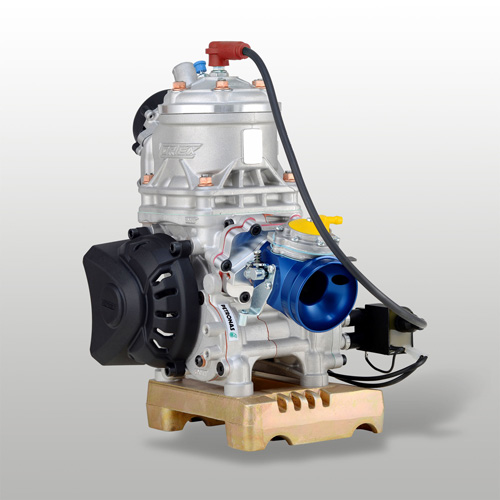
Above: Vortex Rok DVS 125
Australian Distributor, Paul Feeney Group, organized a private test at the Geelong circuit the Monday after the final round of the Australian Kart Championship series.
The PFG/Vortex team had set up several karts in ‘2016’ senior and junior specification for people to have a run.
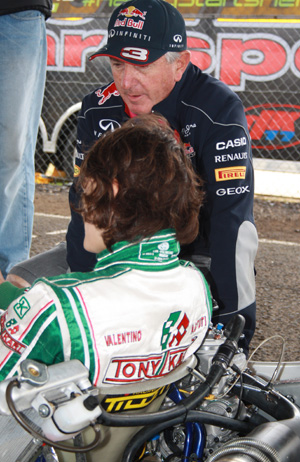
Above: Graham Powles oversaw a number of the juniors testing the DVS
pic - Mark Wicks, KartSportNews
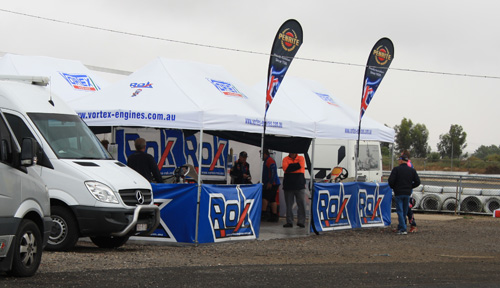
Above: The day after the AKC final
pic - Mark Wicks, KartSportNews
The Vortex Rok DVS
While the DVS is in the spirit of the new generation CIK-FIA “OK” regulations, it is not Vortex’s homologated OK engine.
The DVS is a 125cc water-cooled, reed-valve engine, but has no on-board starter, clutch, wiring loom or battery. The lower weight makes it a lighter and more maneuverable machine than a TaG kart. It’s also direct drive. While this means it’s back to push starting, the de-compression valve in the head means there is no requirement for pushers to lift the rear of the kart off the ground to get the bump-start happening.
There are three key differences between the ‘senior’ DVS and the ‘junior’ version:
- Power Valve (changes exhaust port timing as a function of revs/exhaust pressure) - Senior cylinder has one, the Junior cylinder does not (just like the Senior Vs Junior Rotax MAX)
- Exhaust pipe/silencer – Completely different muffler, tuned to the Senior or Junior DVS cylinder
- Ignition Module – Different characteristics for each engine, includes built-in rev limiter (Senior: 16,000rpm, Junior: 14,000rpm).
What this means is the motor meets KA’s ‘pathway’ requirement of being able to be upgraded from junior to senior competition.
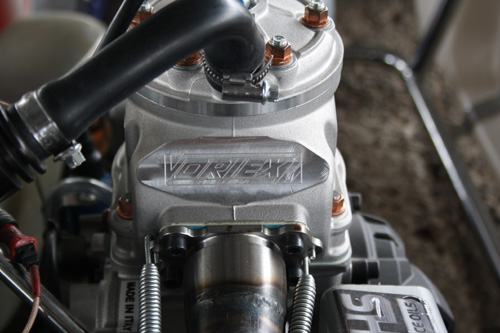
Above: Like the Rotax MAX, the Junior version of the DVS cylinder does not have an exhaust power valve
pic - Mark Wicks, KartSportNews
The cylinder is cast iron with CNC ports, has a balance shaft for smoother running and pumps out 38hp in Senior spec (@11,000rpm) and 28hp in Junior spec (@10,000rpm).
The engines come as a complete kit that includes the motor with Ibea carburetor and Arrow intake silencer, plus the appropriate ignition and DVS exhaust. Recommended Retail Pricing (includes GST) - Junior DVS: $4190, Senior DVS: $4390.
Also, the DVS is a ‘fixed spec’ engine, must be run as homologated and is not subject to further development, Feeney telling me there will be no evolutions or upgrades for DVS.
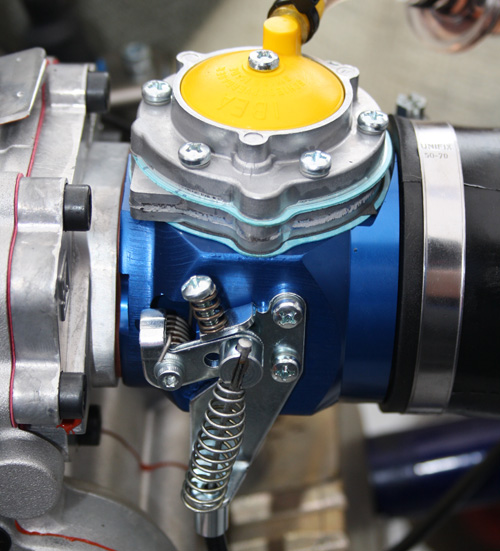
Above: High quality IBEA carburettor for the Rok DVS, 24mm diameter
pic - Mark Wicks, KartSportNews
On-Track
Apart from me being too fat for the seat in the senior kart, the DVS felt good!
Bolted to a Kosmic chassis running MG Yellow tyres, the DVS fired without issue (start with zero throttle then, when it fires, gradually crack the throttle to about one-eighth and begin to drive away).
On new MG Yellows and a track that had just seen three days of hard racing, the Geelong circuit was pretty grippy, particularly so for someone who hasn’t raced competitively for so long.
With gearing to cope with the circuit's long straight, the motor did feel a bit soft on the tight section of the infield. But when the DVS gets up and goes, it really goes! Keeping the tail in line as the power came in through the sweeper was fun. Also, the DVS sounds much more like how a high performance kart engine should.
A couple of drivers at the track who have race experience with a KF2, also tested the DVS and tell me this engine is smoother and more forgiving. The DVS has much less of the “two stage” power delivery of the KF2s they’d been running.
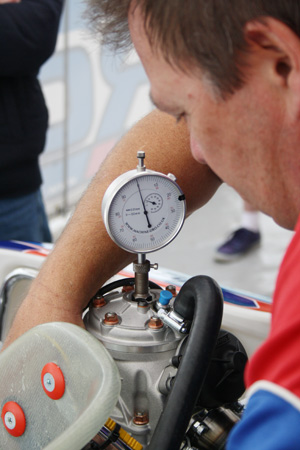
Above: Playing with ignition timing
pic - Mark Wicks, KartSportNews
Push Starting
While the DVS is an excellent, well engineered piece of kit, is going back to direct drive and push starting appropriate for modern karting?
One could justifiably argue the OK concept - of which the Rok DVS is but one example - is a step backwards in this litigious world (think, lots of people trying to avoid karts on the out grid).
In my opinion, lighter direct-drive engined karts are more fun to drive from a handling and on-track perspective than the heavier TaG-style equivalent.
However, observations on the test day led me to this conclusion: teams are going to need to get fitter starter motors!
The increase in popularity of TaG-engined classes in Australian karting means lots of karters and their crews have lost the ability to push-start effectively. In fact, many of today’s racers have had no exposure to such a thing!
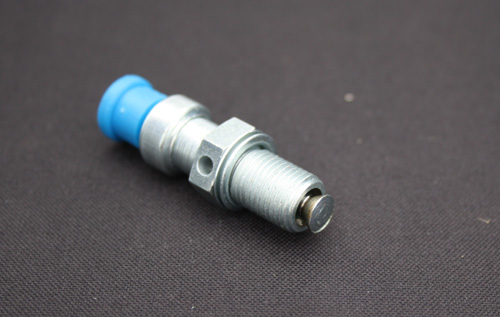
Above: Decompression valve open. When the engine turns over, the intake charge can escape from the combustion chamber via this valve. But when the engine fires for the first time, combustion chamber presssure snaps the valve closed. Depending on gearing, that can happen at very low road speed, so the pushers must remember to keep pushing until the kart can drive away. On the test day, some pushers bailed out as soon as the engine fired first time. That’s not going to do the job.
pic - Mark Wicks, KartSportNews
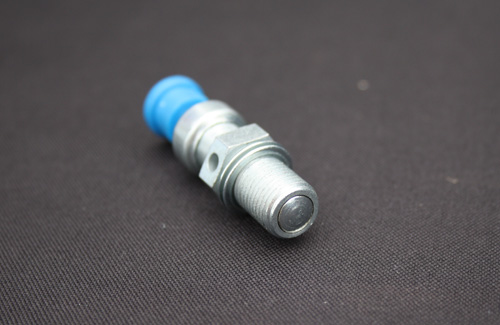
Above: Decompression valve closed
pic - Mark Wicks, KartSportNews
The instructions to me as the driver when starting were “carry no throttle when being pushed, then once it fires the first time, crack it open to about an eighth until it starts to pick and then introduce more gas and drive away”. That’s exactly what I did, and I drove off down pit lane without issue.
But the same can’t be said for a few of the others, and one of the junior karts was proving troublesome. Whether that was because of driver input, pushers not up to the job, or inherent tuning of the engine (mechanics were playing around with the ignition timing), I don’t know. For the drivers and their pushers using this engine, there’s going to be a bit of a re-education process.
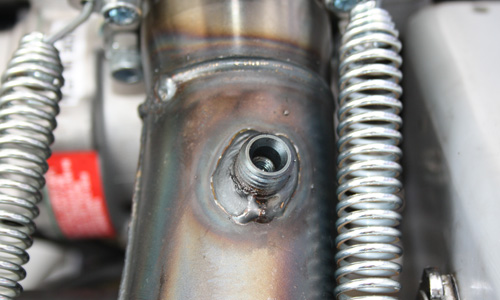
Above: All the exhausts (senior and junior) come with EGT fitting pre-welded, but not drilled through
pic - Mark Wicks, KartSportNews
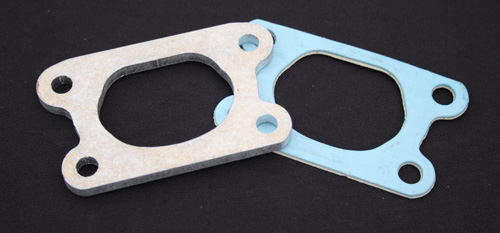
Above & Below: For the Senior DVS, an exhaust spacer and gasket can be fitted or removed from between the cylinder and header to tune power delivery
pic - Mark Wicks, KartSportNews
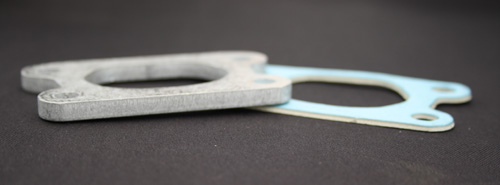
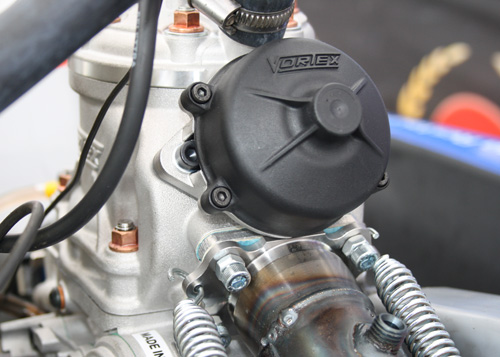
Above & Below: Power valve on the senior DVS (note extra spacer between heaader and cylinder)
pic - Mark Wicks, KartSportNews
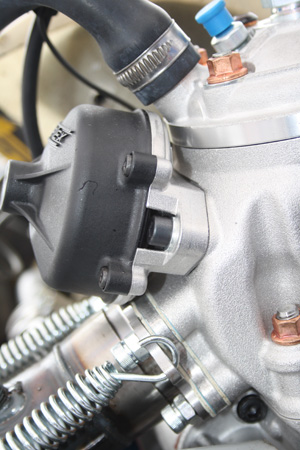
Conclusion
The engine's good, but will it save KF2? I'll close with a quote from 2015 Championship runner-up Scott Sorenson as found in the PFG/Rok info pack: "It is an amazing engine and once you drive one you'll be jumping out of your skin for more, it is just that good! If introducing the new Vortex Rok DVS engine does not fix the KF2 class, nothing will."
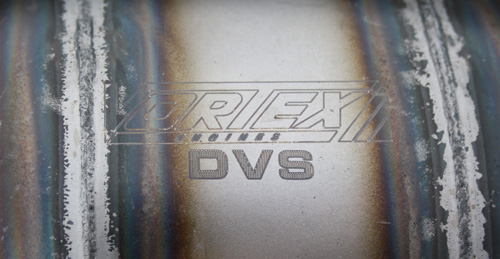
Above: Vortex etching on the senior muffler
pic - Mark Wicks, KartSportNews
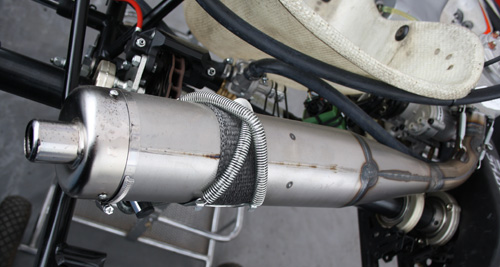
Above: Junior DVS muffler, externally quite similar to traditional 100cc pipes
pic - Mark Wicks, KartSportNews
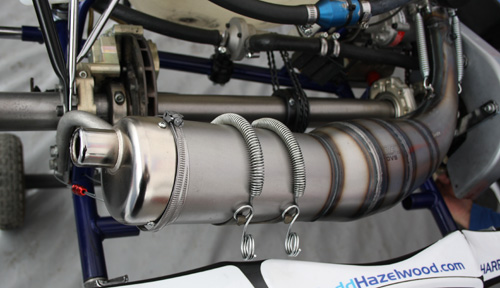
Above: Senior DVS muffler has a much fatter expansion chamber
pic - Mark Wicks, KartSportNews
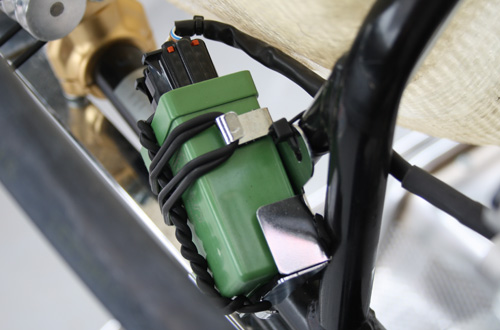
Above: Junior ignition (green box)
pic - Mark Wicks, KartSportNews
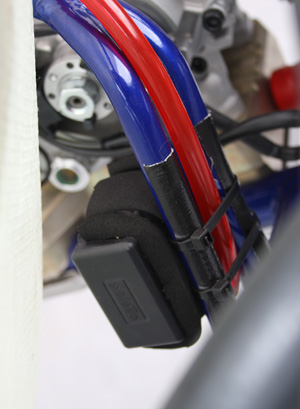
Above: Senior ignition box (black)
pic - Mark Wicks, KartSportNews
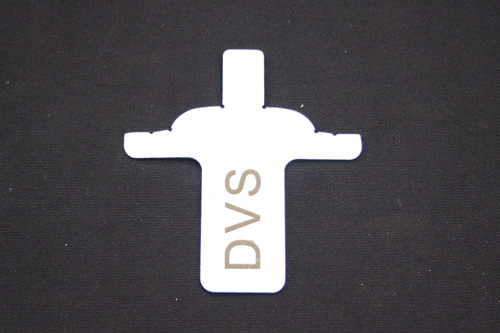
Above: Head combustion chamber template
pic - Mark Wicks, KartSportNews
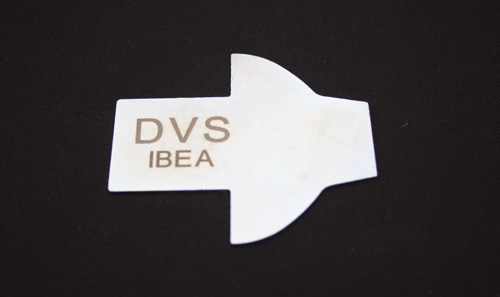
Above: IBEA carburettor profile template. These gauges are a quick and easy check for compliance and that no modifications have been made
pic - Mark Wicks, KartSportNews
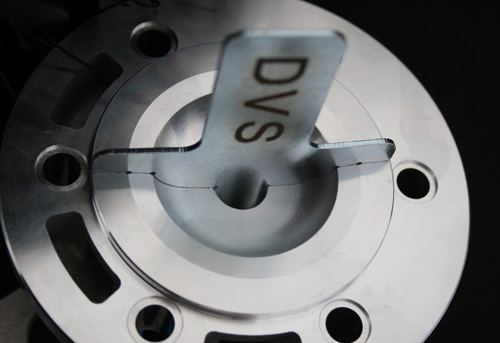
Above: Combustion chamber template fits perfectly in the stock head - as it should!
pic - Mark Wicks, KartSportNews

Above & Below: Vortex's pics of the DVS
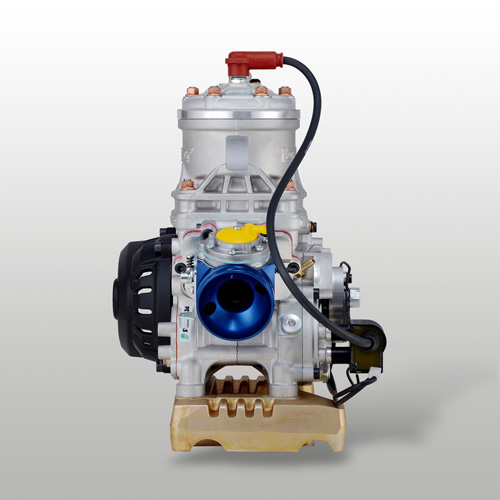
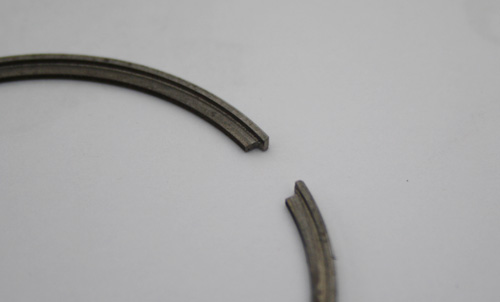
Above: 'L'-shaped piston ring
pic - Mark Wicks, KartSportNews
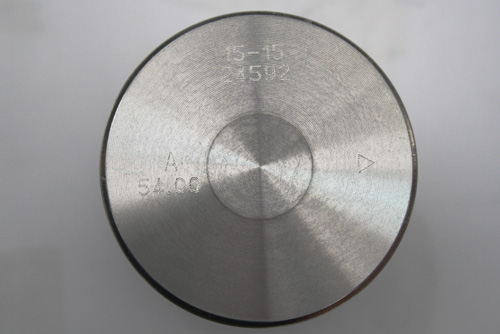
Above: DVS piston, 54.00mm (engine stroke is also 54mm)
pic - Mark Wicks, KartSportNews
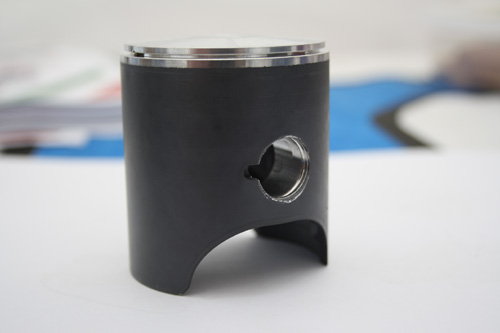
Above: The DVS uses a coated piston
pic - Mark Wicks, KartSportNews
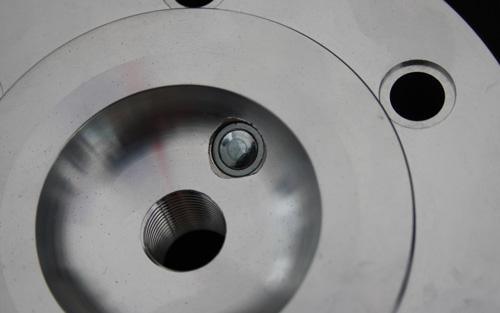
Above: De-compression valve, from the inside
pic - Mark Wicks, KartSportNews
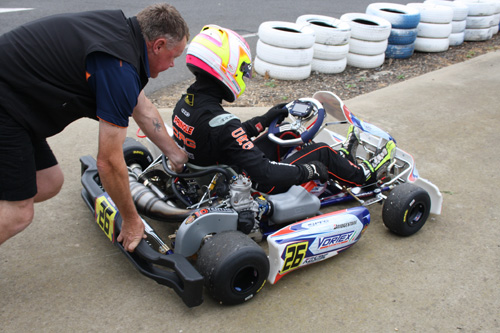
Above: Jason Pringle gets pushed out for a run
pic - Mark Wicks, KartSportNews

